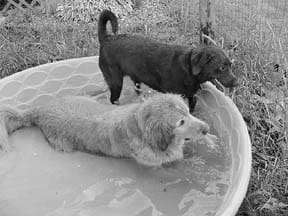There are hundreds of brands and flavors of dog food out there. You can find them everywhere, from the corner convenience store to the members-only warehouse center to the hard-to-find health food store for pets. And by golly, you’ve tried what seems like all of them! Yet you’re still not sure which are the best ones for your dog.
On the other hand, your dog seems to have a definite opinion about it, and really prefers one of the less expensive grocery store brands. That’s great, you think, he loves the food and he’s saving me money! But is he? Is your dog’s preference for a particular food a good indication of the quality of the food?
Sorry, Rover, the answer is an emphatic “No!” A food that is avidly consumed and preferred over all other offerings is more likely to be coated or infused with palatability enhancers than it is to be a truly nutritious and healthful food.

Palatability is a highly developed science in the pet food industry. Extensive resources are poured into this aspect of food production. The trade publication Pet Food Industry publishes articles about palatability in every issue, and many of the companies that place full-page, color ads in the publication produce palatability enhancers. To quote just a few:
• American Dehydrated Foods, Inc., “the quality leader in providing high-performance palatability enhancers”
• Optimizor Brand Flavors, “Raising the palatability bar faster through superior technology”
• BioProducts, Inc., “Palatability enhancers for the new millennium”
And think about pet food commercials on TV: every one features a dog tearing into a bowl of food like it’s his last meal. Pet food makers know that to appeal to us, they have to appeal to our dogs.
Palatability enhancers
The taste of a dog food depends on a variety of factors, from the quality and composition of the raw materials, how they are ground; blended and “preconditioned” (which refers to the moisture and temperature of the dough entering the extruder); the density, texture, shape, moisture content, and size of the finished product; and the application of fats and other palatability enhancers or “palatants.”
Desirable palatants improve animal acceptance while still being easy to apply, safe, inexpensive, and not aversive to the human nose. There are dozens of palatants marketed to pet food manufacturers. These fall into several broad categories: digests (chemically or enzymatically digested animal tissues that provide a meaty taste), processed meat flavors, oil-based flavors, yeast products, other “savory” flavors (garlic, cheese, bacon), and “masking” flavors which are intended to disguise unpleasant odors.
Dog food flavors must also be stable over time, and under various potential storage conditions (from a hot warehouse to a cold basement). So preservatives are considered in the palatability picture, since they defend against ingredient decay; and the oxidation of fats, which produces a rancid odor and taste, must be prevented with antioxidants. Antimicrobial agents defend the food from mold. The tendency to get stale must be overcome by adding certain emulsifiers. All of these chemicals factor into the food’s appeal from when the packaging is first opened to the bottom of the bag.
Fewer additives in canned
Speaking of packaging, canned foods usually contain a greater proportion of (and more appealing) meat or animal-based ingredients than dry food, and the moisture in canned food also appeals to dogs, so canned foods generally contain fewer palatants.
Dry foods, in contrast, are generally comprised of at least half corn or other cereal grains – not high on the typical canine list of favorites – and so palatants are important if the food is to be appetizing to dogs. A great deal of research has gone into dry dog food bags in order for them to preserve the food at an optimum level of attractiveness to the dog, resulting in innovations such as zip-lock or other resealable closures and vacuum-packed foods.
Dog food manufacturers typically perform “taste tests” for each given flavor or variety of their products on 20 or more dogs. And these are not just ordinary dogs! They have been trained to sample food from each bowl offered to them, and the testing procedures are repeatedly examined to ensure the tests are free of unintentional bias; for example, that the testers unwittingly set up the test prefer whatever is in the bowl on the right, or the presence of some other obscure cue. Three to five trials are done over several days to allow for normal fluctuations in the dogs’ physiological states.
Taste can steer a dog wrong
While wild canids like wolves and foxes are savvy about what is good for them and what isn’t, the many disguises that palatants and preservatives provide to dry food can confuse the dog’s senses. Palatants can (and do) make poor quality foods smell and taste good. One could probably spray-coat wood chips or shredded rubber with tasty, oily palatants that would have dogs wolfing them down, with little or no nutritional benefit.
Think it through: You wouldn’t give a three-year-old child sole control of her menu – given her taste and lack of nutritional knowledge, she would likely end up subsisting on a diet of Cocoa Puffs, Cheetos, and Hawaiian Punch. Neither should you trust your dog to choose his food by taste or smell. It’s up to you to do the investigation needed to assure him of good nutrition.
Oddly, in 1998, the usually reliable Consumer Reports fell into this very trap, imagining that taste is indicative of quality. In its survey of pet foods, the magazine’s reporters referred to some scientifically valid chemical analysis of various foods. But they also included a listing of food choices made by dogs and cats belonging to staff members. This article drew strong criticism from both veterinarians and pet food makers, who universally complained about the unprofessional methodology of Consumer Union’s taste tests. (The winner in the Consumer Reports taste tests? Heinz Pet Products’ Kibbles ‘N Bits, a food that is loaded with sugar, salt, digests, and other palatants, as well as artificial colors, preservatives, and emulsifiers.)
Another drawback of a really delicious food is that your dog is liable to overeat. He may eat with such gusto that you’ll treat him to an extra handful – and dry food is a very dense source of calories. Do that often enough, and he’ll start putting on the pounds. That’s not doing him any favors! Obesity is one of the most common health problems seen by veterinarians, and leads to extra stress on the joints, heart, liver, and kidneys. It’s a whole lot easier to avoid that extra fat than it is to get rid of it once it’s there – and don’t we all have experience with that?! To your pup, a little is as good as a lot, and he’ll probably be just as thrilled with a little less as a little more.
Not a selection factor
We’re certainly not advocating the purchase of foods that your dog doesn’t like. Palatants have a place in dog food production; after all, without them, dogs might not eat many of the commercial foods on the market today. Although advocates of raw food diets might consider this a good thing, it’s certainly important that a food be tasty enough to attract a dog to eat enough to provide for his basic nutritional needs. Just don’t let his preference become your main criteria.
-By Jean Hofve, DVM
Until recently, Dr. Jean Hofve had a holistic veterinary practice in Denver, Colorado. Now she gets to advocate for animals in a new way, as the Companion Animal Program Coordinator for the Animal Protection Institute, located in Sacramento, California.





Like the intellectual presentato on of material, but haven’t seen a way to find out if you have cat food. Will not try any harder. Back to solitaire.
Love to buy USA sustainable products.